Human Resource Development Report: Strategy, Behavior, and Improvement
VerifiedAdded on 2021/04/16
|13
|2807
|32
Report
AI Summary
This report provides an in-depth analysis of Human Resource Development (HRD) and its critical role in organizational success. It explores the relationship between HRD and organizational strategy, examining how HRD activities like recruitment, training, and performance appraisal align with and support overall business objectives. The report evaluates the influence of HR practices on employee behavior, including motivation, commitment, and performance. It also discusses two key activities, HR strategy linkage and employee behavior influence. Furthermore, it offers practical suggestions for improvement within the HR department, such as hiring HR generalists, aligning HR and business objectives, and providing flexible learning options. The report concludes with recommendations for enhancing HR practices to drive organizational effectiveness and achieve strategic goals. The report emphasizes the importance of HRD in maximizing employee capabilities, fostering innovation, and improving product and service quality.
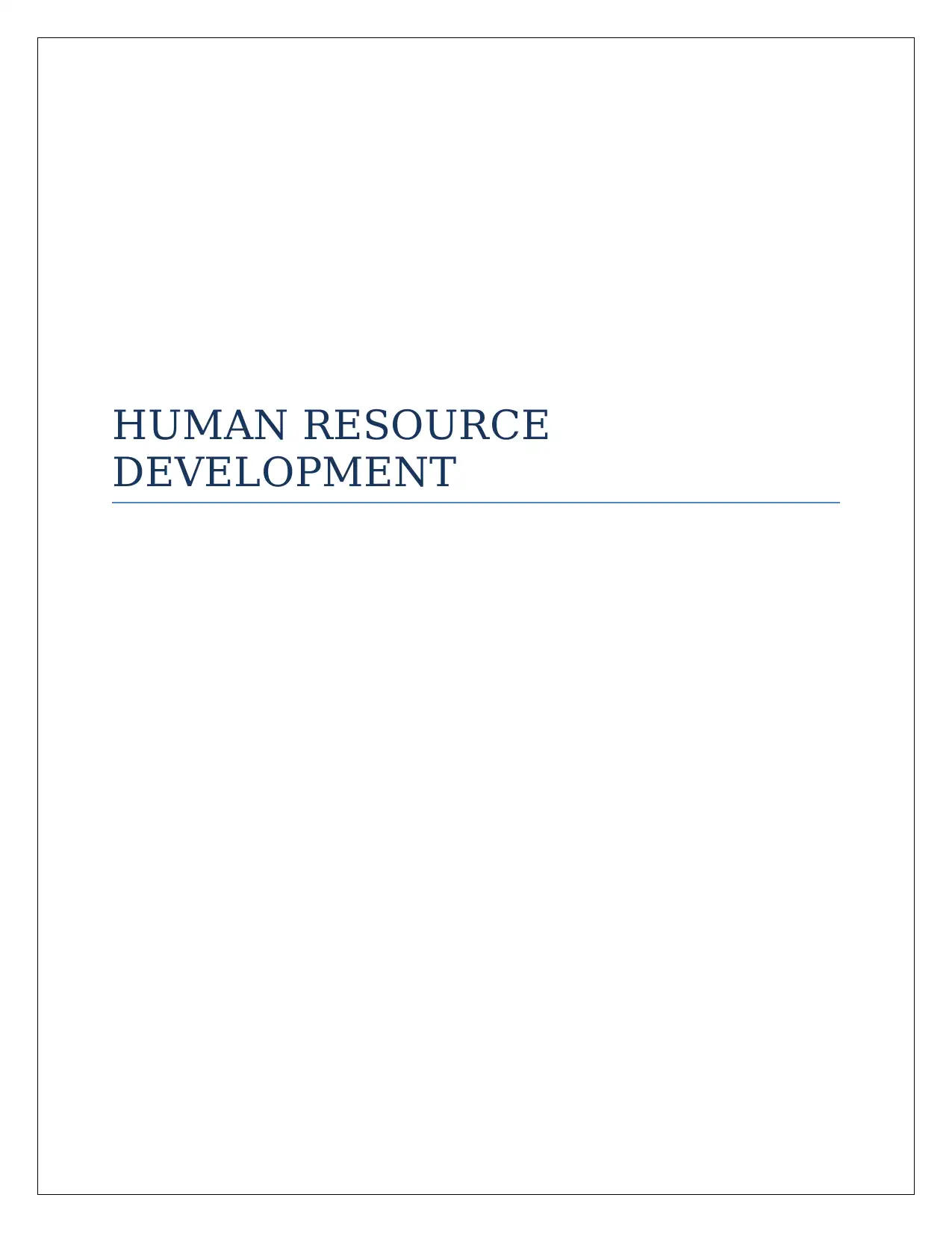
HUMAN RESOURCE
DEVELOPMENT
DEVELOPMENT
Paraphrase This Document
Need a fresh take? Get an instant paraphrase of this document with our AI Paraphraser
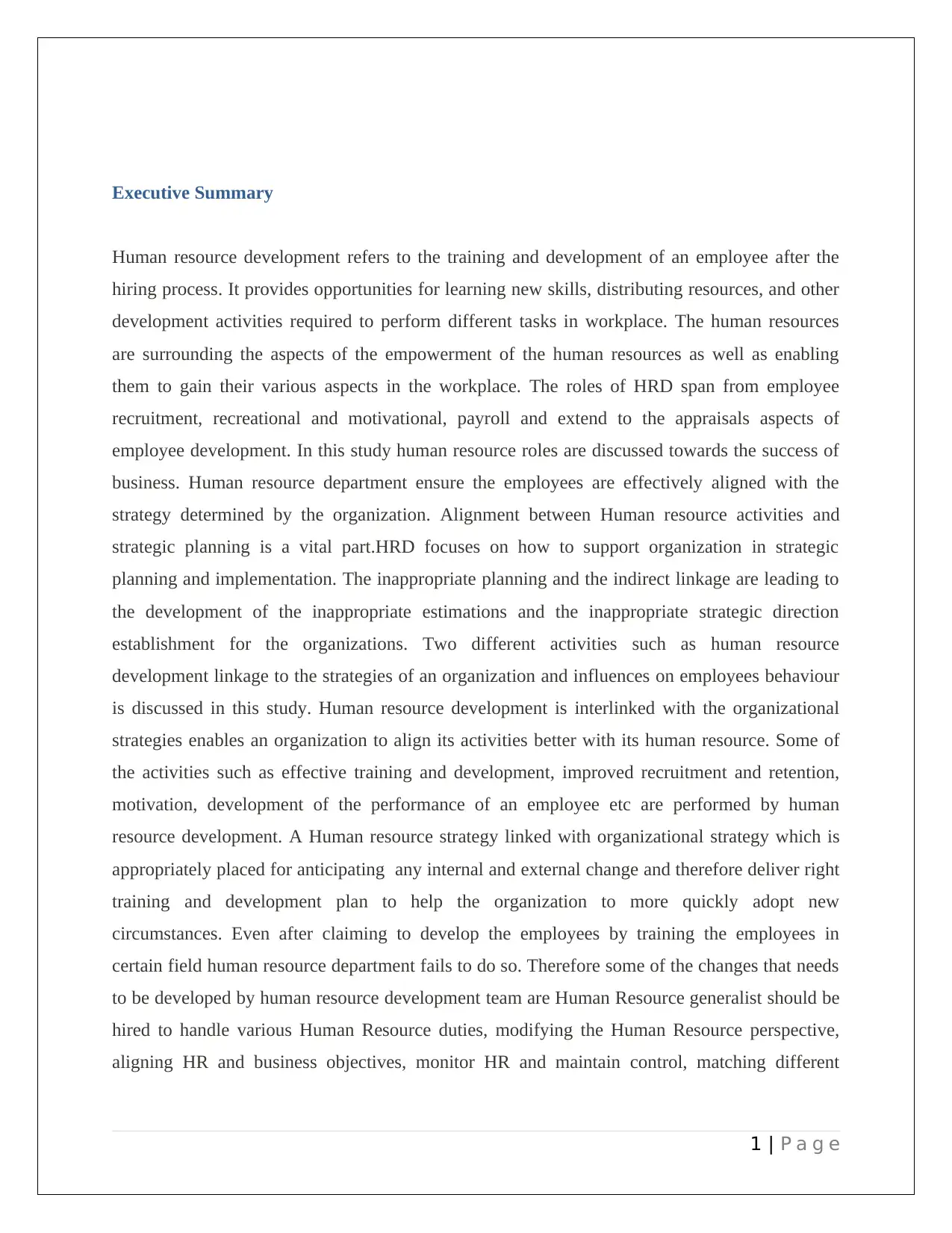
Executive Summary
Human resource development refers to the training and development of an employee after the
hiring process. It provides opportunities for learning new skills, distributing resources, and other
development activities required to perform different tasks in workplace. The human resources
are surrounding the aspects of the empowerment of the human resources as well as enabling
them to gain their various aspects in the workplace. The roles of HRD span from employee
recruitment, recreational and motivational, payroll and extend to the appraisals aspects of
employee development. In this study human resource roles are discussed towards the success of
business. Human resource department ensure the employees are effectively aligned with the
strategy determined by the organization. Alignment between Human resource activities and
strategic planning is a vital part.HRD focuses on how to support organization in strategic
planning and implementation. The inappropriate planning and the indirect linkage are leading to
the development of the inappropriate estimations and the inappropriate strategic direction
establishment for the organizations. Two different activities such as human resource
development linkage to the strategies of an organization and influences on employees behaviour
is discussed in this study. Human resource development is interlinked with the organizational
strategies enables an organization to align its activities better with its human resource. Some of
the activities such as effective training and development, improved recruitment and retention,
motivation, development of the performance of an employee etc are performed by human
resource development. A Human resource strategy linked with organizational strategy which is
appropriately placed for anticipating any internal and external change and therefore deliver right
training and development plan to help the organization to more quickly adopt new
circumstances. Even after claiming to develop the employees by training the employees in
certain field human resource department fails to do so. Therefore some of the changes that needs
to be developed by human resource development team are Human Resource generalist should be
hired to handle various Human Resource duties, modifying the Human Resource perspective,
aligning HR and business objectives, monitor HR and maintain control, matching different
1 | P a g e
Human resource development refers to the training and development of an employee after the
hiring process. It provides opportunities for learning new skills, distributing resources, and other
development activities required to perform different tasks in workplace. The human resources
are surrounding the aspects of the empowerment of the human resources as well as enabling
them to gain their various aspects in the workplace. The roles of HRD span from employee
recruitment, recreational and motivational, payroll and extend to the appraisals aspects of
employee development. In this study human resource roles are discussed towards the success of
business. Human resource department ensure the employees are effectively aligned with the
strategy determined by the organization. Alignment between Human resource activities and
strategic planning is a vital part.HRD focuses on how to support organization in strategic
planning and implementation. The inappropriate planning and the indirect linkage are leading to
the development of the inappropriate estimations and the inappropriate strategic direction
establishment for the organizations. Two different activities such as human resource
development linkage to the strategies of an organization and influences on employees behaviour
is discussed in this study. Human resource development is interlinked with the organizational
strategies enables an organization to align its activities better with its human resource. Some of
the activities such as effective training and development, improved recruitment and retention,
motivation, development of the performance of an employee etc are performed by human
resource development. A Human resource strategy linked with organizational strategy which is
appropriately placed for anticipating any internal and external change and therefore deliver right
training and development plan to help the organization to more quickly adopt new
circumstances. Even after claiming to develop the employees by training the employees in
certain field human resource department fails to do so. Therefore some of the changes that needs
to be developed by human resource development team are Human Resource generalist should be
hired to handle various Human Resource duties, modifying the Human Resource perspective,
aligning HR and business objectives, monitor HR and maintain control, matching different
1 | P a g e

learning options to different learning styles, building trust in organizational leadership, serving
the learning needs of more virtual teams, providing flexible learning options etc.
2 | P a g e
the learning needs of more virtual teams, providing flexible learning options etc.
2 | P a g e
⊘ This is a preview!⊘
Do you want full access?
Subscribe today to unlock all pages.

Trusted by 1+ million students worldwide
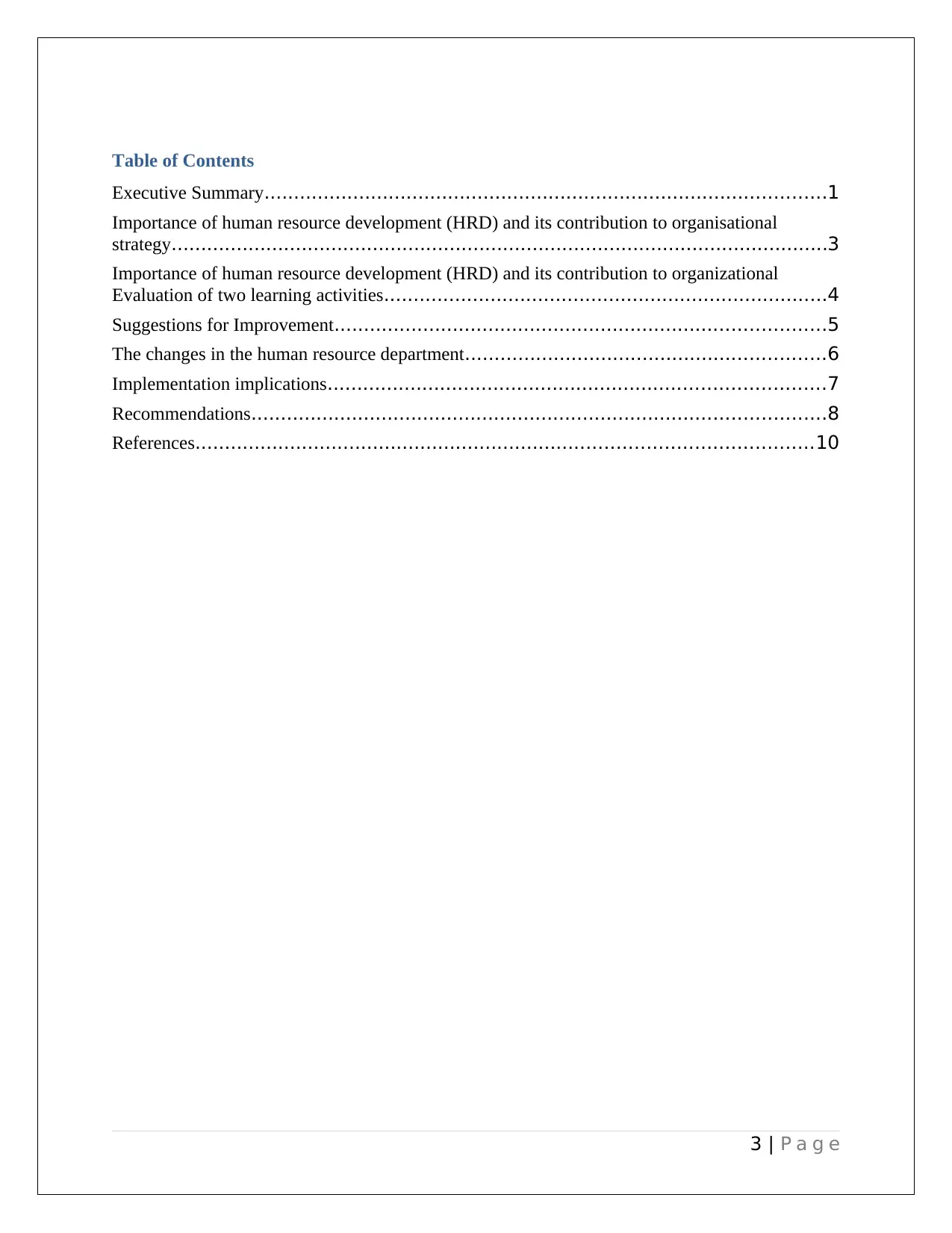
Table of Contents
Executive Summary...............................................................................................1
Importance of human resource development (HRD) and its contribution to organisational
strategy...............................................................................................................3
Importance of human resource development (HRD) and its contribution to organizational
Evaluation of two learning activities...........................................................................4
Suggestions for Improvement...................................................................................5
The changes in the human resource department.............................................................6
Implementation implications....................................................................................7
Recommendations.................................................................................................8
References........................................................................................................10
3 | P a g e
Executive Summary...............................................................................................1
Importance of human resource development (HRD) and its contribution to organisational
strategy...............................................................................................................3
Importance of human resource development (HRD) and its contribution to organizational
Evaluation of two learning activities...........................................................................4
Suggestions for Improvement...................................................................................5
The changes in the human resource department.............................................................6
Implementation implications....................................................................................7
Recommendations.................................................................................................8
References........................................................................................................10
3 | P a g e
Paraphrase This Document
Need a fresh take? Get an instant paraphrase of this document with our AI Paraphraser
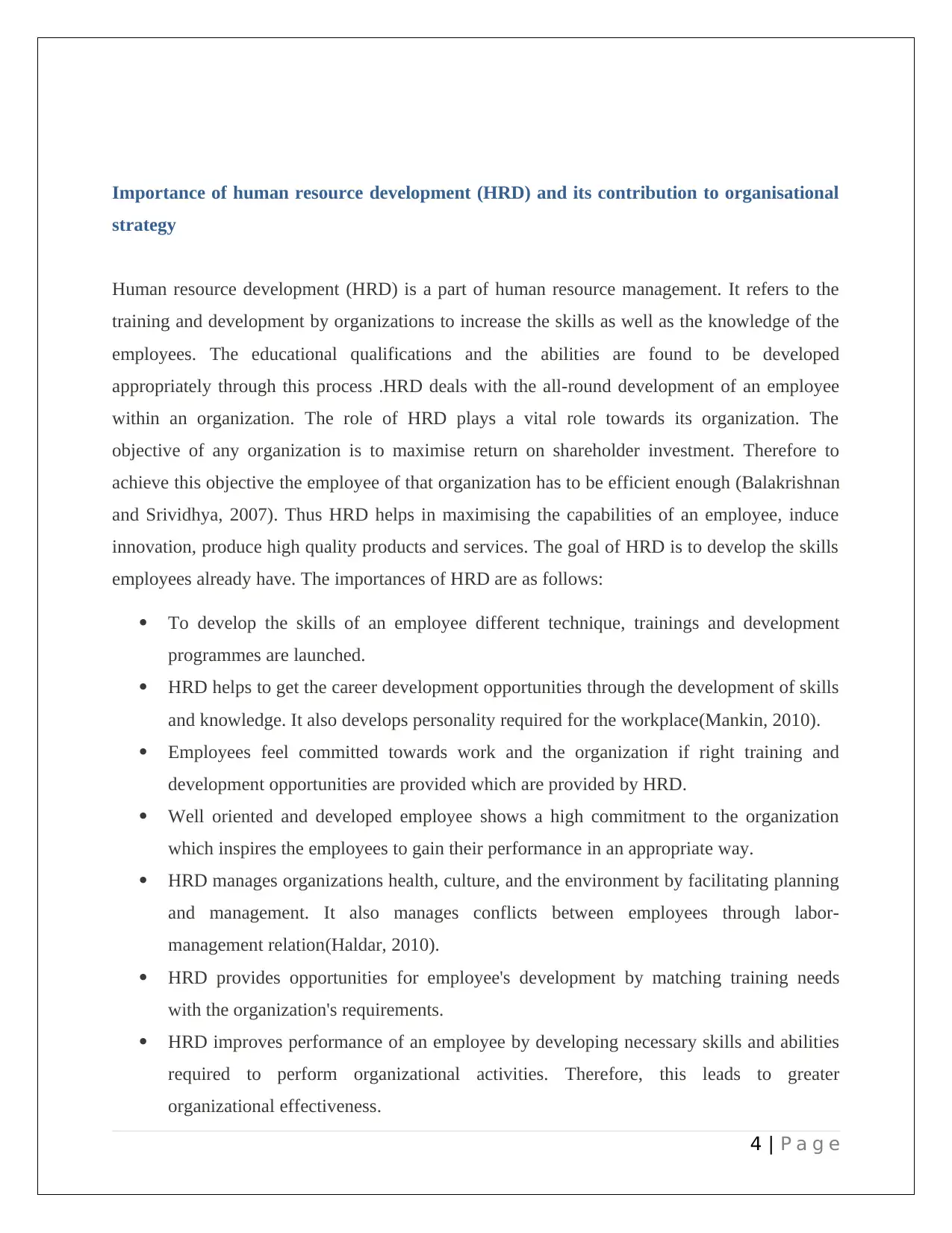
Importance of human resource development (HRD) and its contribution to organisational
strategy
Human resource development (HRD) is a part of human resource management. It refers to the
training and development by organizations to increase the skills as well as the knowledge of the
employees. The educational qualifications and the abilities are found to be developed
appropriately through this process .HRD deals with the all-round development of an employee
within an organization. The role of HRD plays a vital role towards its organization. The
objective of any organization is to maximise return on shareholder investment. Therefore to
achieve this objective the employee of that organization has to be efficient enough (Balakrishnan
and Srividhya, 2007). Thus HRD helps in maximising the capabilities of an employee, induce
innovation, produce high quality products and services. The goal of HRD is to develop the skills
employees already have. The importances of HRD are as follows:
To develop the skills of an employee different technique, trainings and development
programmes are launched.
HRD helps to get the career development opportunities through the development of skills
and knowledge. It also develops personality required for the workplace(Mankin, 2010).
Employees feel committed towards work and the organization if right training and
development opportunities are provided which are provided by HRD.
Well oriented and developed employee shows a high commitment to the organization
which inspires the employees to gain their performance in an appropriate way.
HRD manages organizations health, culture, and the environment by facilitating planning
and management. It also manages conflicts between employees through labor-
management relation(Haldar, 2010).
HRD provides opportunities for employee's development by matching training needs
with the organization's requirements.
HRD improves performance of an employee by developing necessary skills and abilities
required to perform organizational activities. Therefore, this leads to greater
organizational effectiveness.
4 | P a g e
strategy
Human resource development (HRD) is a part of human resource management. It refers to the
training and development by organizations to increase the skills as well as the knowledge of the
employees. The educational qualifications and the abilities are found to be developed
appropriately through this process .HRD deals with the all-round development of an employee
within an organization. The role of HRD plays a vital role towards its organization. The
objective of any organization is to maximise return on shareholder investment. Therefore to
achieve this objective the employee of that organization has to be efficient enough (Balakrishnan
and Srividhya, 2007). Thus HRD helps in maximising the capabilities of an employee, induce
innovation, produce high quality products and services. The goal of HRD is to develop the skills
employees already have. The importances of HRD are as follows:
To develop the skills of an employee different technique, trainings and development
programmes are launched.
HRD helps to get the career development opportunities through the development of skills
and knowledge. It also develops personality required for the workplace(Mankin, 2010).
Employees feel committed towards work and the organization if right training and
development opportunities are provided which are provided by HRD.
Well oriented and developed employee shows a high commitment to the organization
which inspires the employees to gain their performance in an appropriate way.
HRD manages organizations health, culture, and the environment by facilitating planning
and management. It also manages conflicts between employees through labor-
management relation(Haldar, 2010).
HRD provides opportunities for employee's development by matching training needs
with the organization's requirements.
HRD improves performance of an employee by developing necessary skills and abilities
required to perform organizational activities. Therefore, this leads to greater
organizational effectiveness.
4 | P a g e
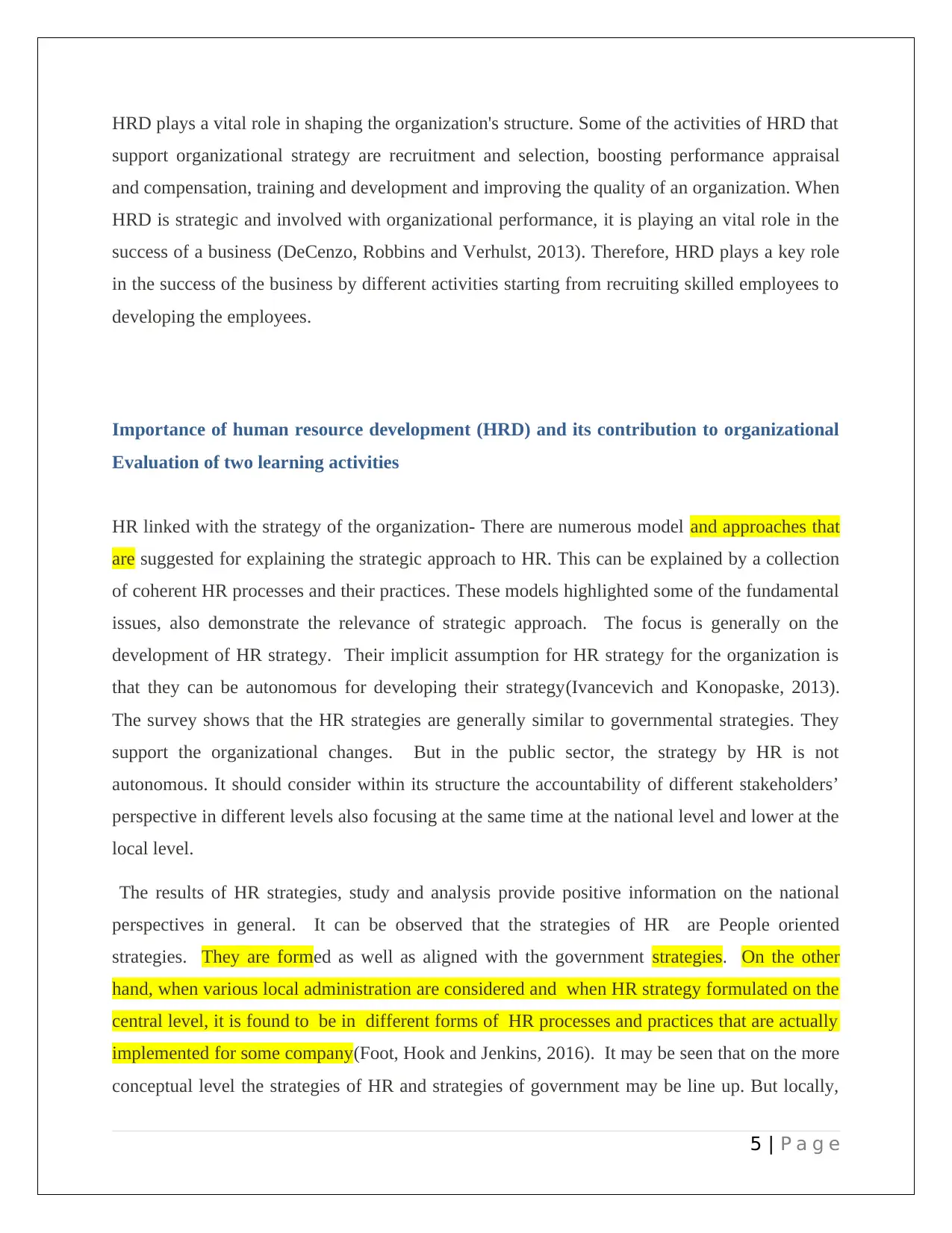
HRD plays a vital role in shaping the organization's structure. Some of the activities of HRD that
support organizational strategy are recruitment and selection, boosting performance appraisal
and compensation, training and development and improving the quality of an organization. When
HRD is strategic and involved with organizational performance, it is playing an vital role in the
success of a business (DeCenzo, Robbins and Verhulst, 2013). Therefore, HRD plays a key role
in the success of the business by different activities starting from recruiting skilled employees to
developing the employees.
Importance of human resource development (HRD) and its contribution to organizational
Evaluation of two learning activities
HR linked with the strategy of the organization- There are numerous model and approaches that
are suggested for explaining the strategic approach to HR. This can be explained by a collection
of coherent HR processes and their practices. These models highlighted some of the fundamental
issues, also demonstrate the relevance of strategic approach. The focus is generally on the
development of HR strategy. Their implicit assumption for HR strategy for the organization is
that they can be autonomous for developing their strategy(Ivancevich and Konopaske, 2013).
The survey shows that the HR strategies are generally similar to governmental strategies. They
support the organizational changes. But in the public sector, the strategy by HR is not
autonomous. It should consider within its structure the accountability of different stakeholders’
perspective in different levels also focusing at the same time at the national level and lower at the
local level.
The results of HR strategies, study and analysis provide positive information on the national
perspectives in general. It can be observed that the strategies of HR are People oriented
strategies. They are formed as well as aligned with the government strategies. On the other
hand, when various local administration are considered and when HR strategy formulated on the
central level, it is found to be in different forms of HR processes and practices that are actually
implemented for some company(Foot, Hook and Jenkins, 2016). It may be seen that on the more
conceptual level the strategies of HR and strategies of government may be line up. But locally,
5 | P a g e
support organizational strategy are recruitment and selection, boosting performance appraisal
and compensation, training and development and improving the quality of an organization. When
HRD is strategic and involved with organizational performance, it is playing an vital role in the
success of a business (DeCenzo, Robbins and Verhulst, 2013). Therefore, HRD plays a key role
in the success of the business by different activities starting from recruiting skilled employees to
developing the employees.
Importance of human resource development (HRD) and its contribution to organizational
Evaluation of two learning activities
HR linked with the strategy of the organization- There are numerous model and approaches that
are suggested for explaining the strategic approach to HR. This can be explained by a collection
of coherent HR processes and their practices. These models highlighted some of the fundamental
issues, also demonstrate the relevance of strategic approach. The focus is generally on the
development of HR strategy. Their implicit assumption for HR strategy for the organization is
that they can be autonomous for developing their strategy(Ivancevich and Konopaske, 2013).
The survey shows that the HR strategies are generally similar to governmental strategies. They
support the organizational changes. But in the public sector, the strategy by HR is not
autonomous. It should consider within its structure the accountability of different stakeholders’
perspective in different levels also focusing at the same time at the national level and lower at the
local level.
The results of HR strategies, study and analysis provide positive information on the national
perspectives in general. It can be observed that the strategies of HR are People oriented
strategies. They are formed as well as aligned with the government strategies. On the other
hand, when various local administration are considered and when HR strategy formulated on the
central level, it is found to be in different forms of HR processes and practices that are actually
implemented for some company(Foot, Hook and Jenkins, 2016). It may be seen that on the more
conceptual level the strategies of HR and strategies of government may be line up. But locally,
5 | P a g e
⊘ This is a preview!⊘
Do you want full access?
Subscribe today to unlock all pages.

Trusted by 1+ million students worldwide
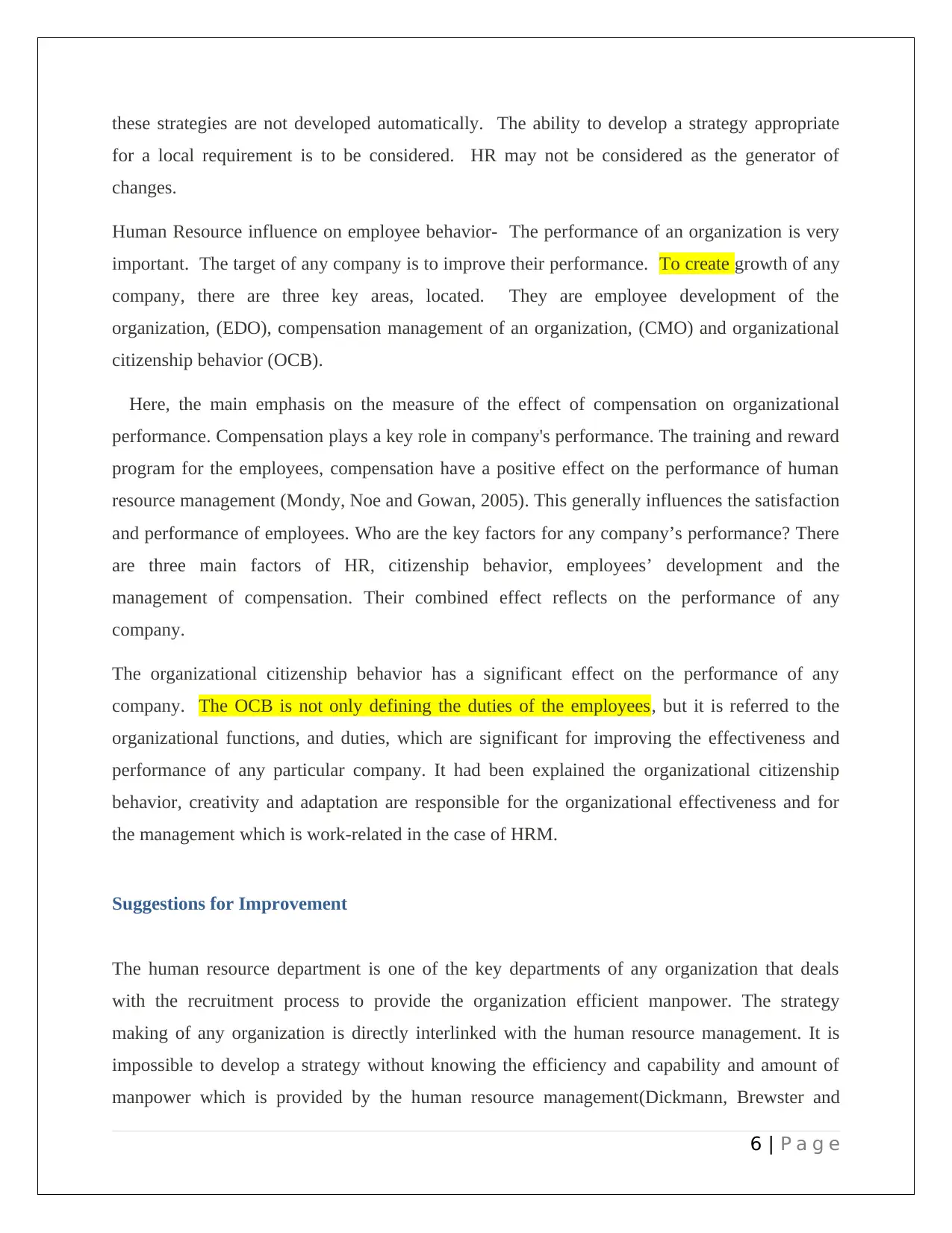
these strategies are not developed automatically. The ability to develop a strategy appropriate
for a local requirement is to be considered. HR may not be considered as the generator of
changes.
Human Resource influence on employee behavior- The performance of an organization is very
important. The target of any company is to improve their performance. To create growth of any
company, there are three key areas, located. They are employee development of the
organization, (EDO), compensation management of an organization, (CMO) and organizational
citizenship behavior (OCB).
Here, the main emphasis on the measure of the effect of compensation on organizational
performance. Compensation plays a key role in company's performance. The training and reward
program for the employees, compensation have a positive effect on the performance of human
resource management (Mondy, Noe and Gowan, 2005). This generally influences the satisfaction
and performance of employees. Who are the key factors for any company’s performance? There
are three main factors of HR, citizenship behavior, employees’ development and the
management of compensation. Their combined effect reflects on the performance of any
company.
The organizational citizenship behavior has a significant effect on the performance of any
company. The OCB is not only defining the duties of the employees, but it is referred to the
organizational functions, and duties, which are significant for improving the effectiveness and
performance of any particular company. It had been explained the organizational citizenship
behavior, creativity and adaptation are responsible for the organizational effectiveness and for
the management which is work-related in the case of HRM.
Suggestions for Improvement
The human resource department is one of the key departments of any organization that deals
with the recruitment process to provide the organization efficient manpower. The strategy
making of any organization is directly interlinked with the human resource management. It is
impossible to develop a strategy without knowing the efficiency and capability and amount of
manpower which is provided by the human resource management(Dickmann, Brewster and
6 | P a g e
for a local requirement is to be considered. HR may not be considered as the generator of
changes.
Human Resource influence on employee behavior- The performance of an organization is very
important. The target of any company is to improve their performance. To create growth of any
company, there are three key areas, located. They are employee development of the
organization, (EDO), compensation management of an organization, (CMO) and organizational
citizenship behavior (OCB).
Here, the main emphasis on the measure of the effect of compensation on organizational
performance. Compensation plays a key role in company's performance. The training and reward
program for the employees, compensation have a positive effect on the performance of human
resource management (Mondy, Noe and Gowan, 2005). This generally influences the satisfaction
and performance of employees. Who are the key factors for any company’s performance? There
are three main factors of HR, citizenship behavior, employees’ development and the
management of compensation. Their combined effect reflects on the performance of any
company.
The organizational citizenship behavior has a significant effect on the performance of any
company. The OCB is not only defining the duties of the employees, but it is referred to the
organizational functions, and duties, which are significant for improving the effectiveness and
performance of any particular company. It had been explained the organizational citizenship
behavior, creativity and adaptation are responsible for the organizational effectiveness and for
the management which is work-related in the case of HRM.
Suggestions for Improvement
The human resource department is one of the key departments of any organization that deals
with the recruitment process to provide the organization efficient manpower. The strategy
making of any organization is directly interlinked with the human resource management. It is
impossible to develop a strategy without knowing the efficiency and capability and amount of
manpower which is provided by the human resource management(Dickmann, Brewster and
6 | P a g e
Paraphrase This Document
Need a fresh take? Get an instant paraphrase of this document with our AI Paraphraser

Sparrow, 2008). The change of strategy in human resource management can be helpful to ease
the decision-making process, identifying pros and cons of the organizational culture and rectify
the existing strategies.
The changes in the human resource department
The change of strategiesin human resource department can be incorporated by improving the
delivery of the departmental services, need to attain all the departmental goals, the
accomplishment of the entire organizational mission and achieving all the organization goals.
The improvement of the delivery of the departmental services is helpful to deliver all the
required elements to each department. It can be done through the effective use of human resource
management. Moreover, it is helpful in identifying the communicationflaws and gives scopes to
resolve the flaws. The overall success of the organization depends on the successful
accomplishment of the all the departmental goals. The accomplishment and improvement of
departmental goal affect the human resource department. It motivates the human resource
department to hire candidates according to the departmental need and helps to make the
recruitment procedure more authentic(Jones and Martain, 2013). The ultimate mission of an
organization is the profitability. The organizational mission can be successful with the effective
change in human resource department. It affects the human resource department to recruit the
candidates according to the organizational need. Random selection often causes organizational
misery and the organizations fail to achieve their desired goal.
The employee behavior is one of the valuable parts of the organization that is needed to be
changed as per thegoals and needs. It includes the communicat5ion among employees, the
communication between employee and the managerial and the exchange of ideas within the
organization. In order to attain this human resource department should keep healthy relation with
the employees and the employees should be given enough scopes to exchange their
ideas(Salaman, 2006).
7 | P a g e
the decision-making process, identifying pros and cons of the organizational culture and rectify
the existing strategies.
The changes in the human resource department
The change of strategiesin human resource department can be incorporated by improving the
delivery of the departmental services, need to attain all the departmental goals, the
accomplishment of the entire organizational mission and achieving all the organization goals.
The improvement of the delivery of the departmental services is helpful to deliver all the
required elements to each department. It can be done through the effective use of human resource
management. Moreover, it is helpful in identifying the communicationflaws and gives scopes to
resolve the flaws. The overall success of the organization depends on the successful
accomplishment of the all the departmental goals. The accomplishment and improvement of
departmental goal affect the human resource department. It motivates the human resource
department to hire candidates according to the departmental need and helps to make the
recruitment procedure more authentic(Jones and Martain, 2013). The ultimate mission of an
organization is the profitability. The organizational mission can be successful with the effective
change in human resource department. It affects the human resource department to recruit the
candidates according to the organizational need. Random selection often causes organizational
misery and the organizations fail to achieve their desired goal.
The employee behavior is one of the valuable parts of the organization that is needed to be
changed as per thegoals and needs. It includes the communicat5ion among employees, the
communication between employee and the managerial and the exchange of ideas within the
organization. In order to attain this human resource department should keep healthy relation with
the employees and the employees should be given enough scopes to exchange their
ideas(Salaman, 2006).
7 | P a g e

Implementation implications
The improvement of the delivery of the departmental services can be improved-
By hiring efficient and qualified humanresource managers having profound experience in
the HR field
The newly hired managers should recruit candidates according to their efficiency and
capability proper training must be provided for the best result(Barrett and Mayson, 2010).
The attainment of all the organizational goals can be improved by
Giving training to the human resource manager regarding the organizational targets and
goals
The human resource managers should be given extra time and reward to train the new
trainees to make them understand the organizational goals
The accomplishment of the departmental goals can be attained through
The humanresource department should arrange a mock critical situation for each
organizationaldepartment in order to teach them the importance of accomplishing
organizational goals. Moreover, the human resource department should assign
staffs according to the departmental needs(Griffin et al., 2014).
Therecruitment procedure should be based on academic qualification, experience
on the respective field and the ability of the person to handle organizational
pressure. In this case, short-term recruitment can be stated as the best option for
the human resource departments(Analoui, 2007).
.
8 | P a g e
The improvement of the delivery of the departmental services can be improved-
By hiring efficient and qualified humanresource managers having profound experience in
the HR field
The newly hired managers should recruit candidates according to their efficiency and
capability proper training must be provided for the best result(Barrett and Mayson, 2010).
The attainment of all the organizational goals can be improved by
Giving training to the human resource manager regarding the organizational targets and
goals
The human resource managers should be given extra time and reward to train the new
trainees to make them understand the organizational goals
The accomplishment of the departmental goals can be attained through
The humanresource department should arrange a mock critical situation for each
organizationaldepartment in order to teach them the importance of accomplishing
organizational goals. Moreover, the human resource department should assign
staffs according to the departmental needs(Griffin et al., 2014).
Therecruitment procedure should be based on academic qualification, experience
on the respective field and the ability of the person to handle organizational
pressure. In this case, short-term recruitment can be stated as the best option for
the human resource departments(Analoui, 2007).
.
8 | P a g e
⊘ This is a preview!⊘
Do you want full access?
Subscribe today to unlock all pages.

Trusted by 1+ million students worldwide
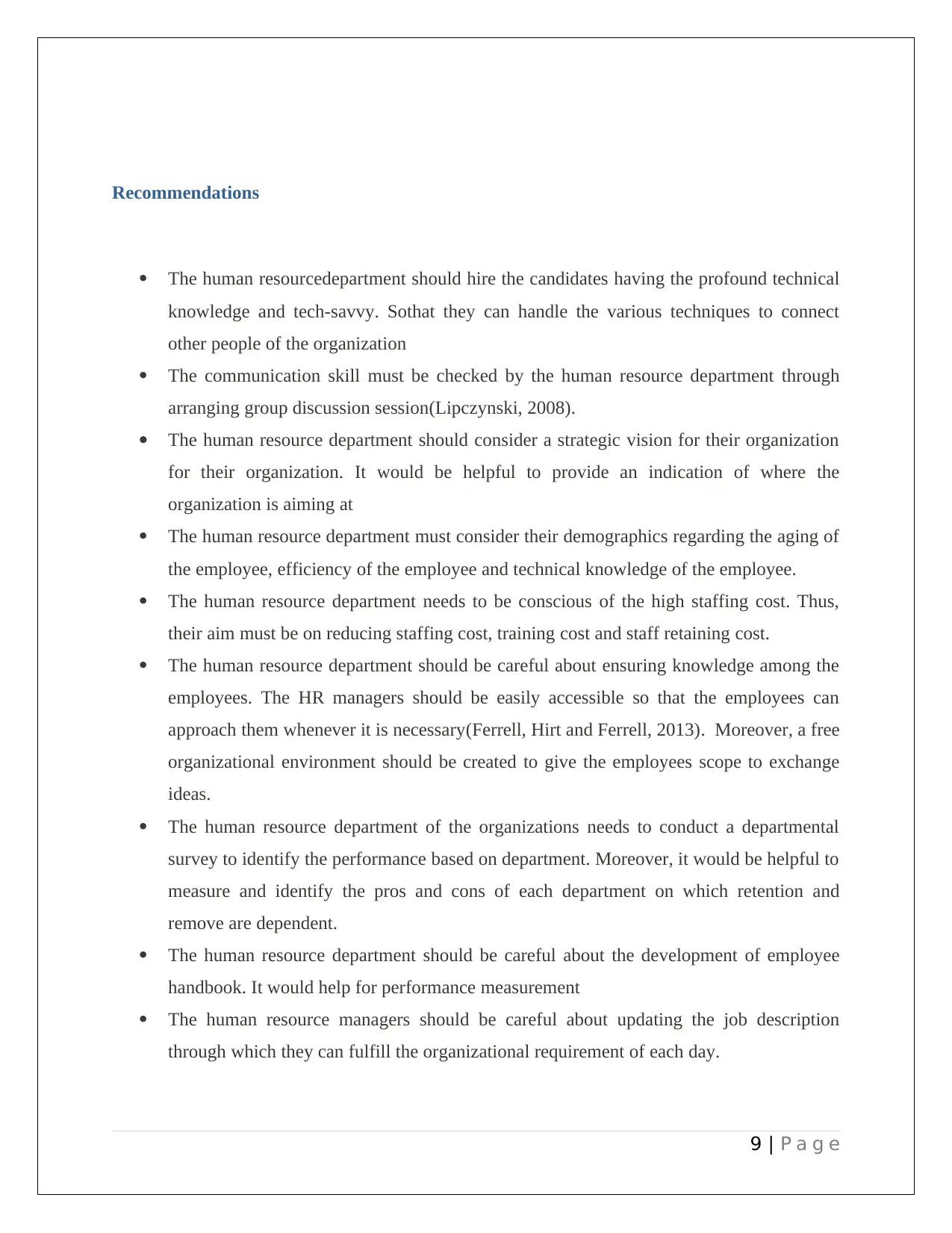
Recommendations
The human resourcedepartment should hire the candidates having the profound technical
knowledge and tech-savvy. Sothat they can handle the various techniques to connect
other people of the organization
The communication skill must be checked by the human resource department through
arranging group discussion session(Lipczynski, 2008).
The human resource department should consider a strategic vision for their organization
for their organization. It would be helpful to provide an indication of where the
organization is aiming at
The human resource department must consider their demographics regarding the aging of
the employee, efficiency of the employee and technical knowledge of the employee.
The human resource department needs to be conscious of the high staffing cost. Thus,
their aim must be on reducing staffing cost, training cost and staff retaining cost.
The human resource department should be careful about ensuring knowledge among the
employees. The HR managers should be easily accessible so that the employees can
approach them whenever it is necessary(Ferrell, Hirt and Ferrell, 2013). Moreover, a free
organizational environment should be created to give the employees scope to exchange
ideas.
The human resource department of the organizations needs to conduct a departmental
survey to identify the performance based on department. Moreover, it would be helpful to
measure and identify the pros and cons of each department on which retention and
remove are dependent.
The human resource department should be careful about the development of employee
handbook. It would help for performance measurement
The human resource managers should be careful about updating the job description
through which they can fulfill the organizational requirement of each day.
9 | P a g e
The human resourcedepartment should hire the candidates having the profound technical
knowledge and tech-savvy. Sothat they can handle the various techniques to connect
other people of the organization
The communication skill must be checked by the human resource department through
arranging group discussion session(Lipczynski, 2008).
The human resource department should consider a strategic vision for their organization
for their organization. It would be helpful to provide an indication of where the
organization is aiming at
The human resource department must consider their demographics regarding the aging of
the employee, efficiency of the employee and technical knowledge of the employee.
The human resource department needs to be conscious of the high staffing cost. Thus,
their aim must be on reducing staffing cost, training cost and staff retaining cost.
The human resource department should be careful about ensuring knowledge among the
employees. The HR managers should be easily accessible so that the employees can
approach them whenever it is necessary(Ferrell, Hirt and Ferrell, 2013). Moreover, a free
organizational environment should be created to give the employees scope to exchange
ideas.
The human resource department of the organizations needs to conduct a departmental
survey to identify the performance based on department. Moreover, it would be helpful to
measure and identify the pros and cons of each department on which retention and
remove are dependent.
The human resource department should be careful about the development of employee
handbook. It would help for performance measurement
The human resource managers should be careful about updating the job description
through which they can fulfill the organizational requirement of each day.
9 | P a g e
Paraphrase This Document
Need a fresh take? Get an instant paraphrase of this document with our AI Paraphraser
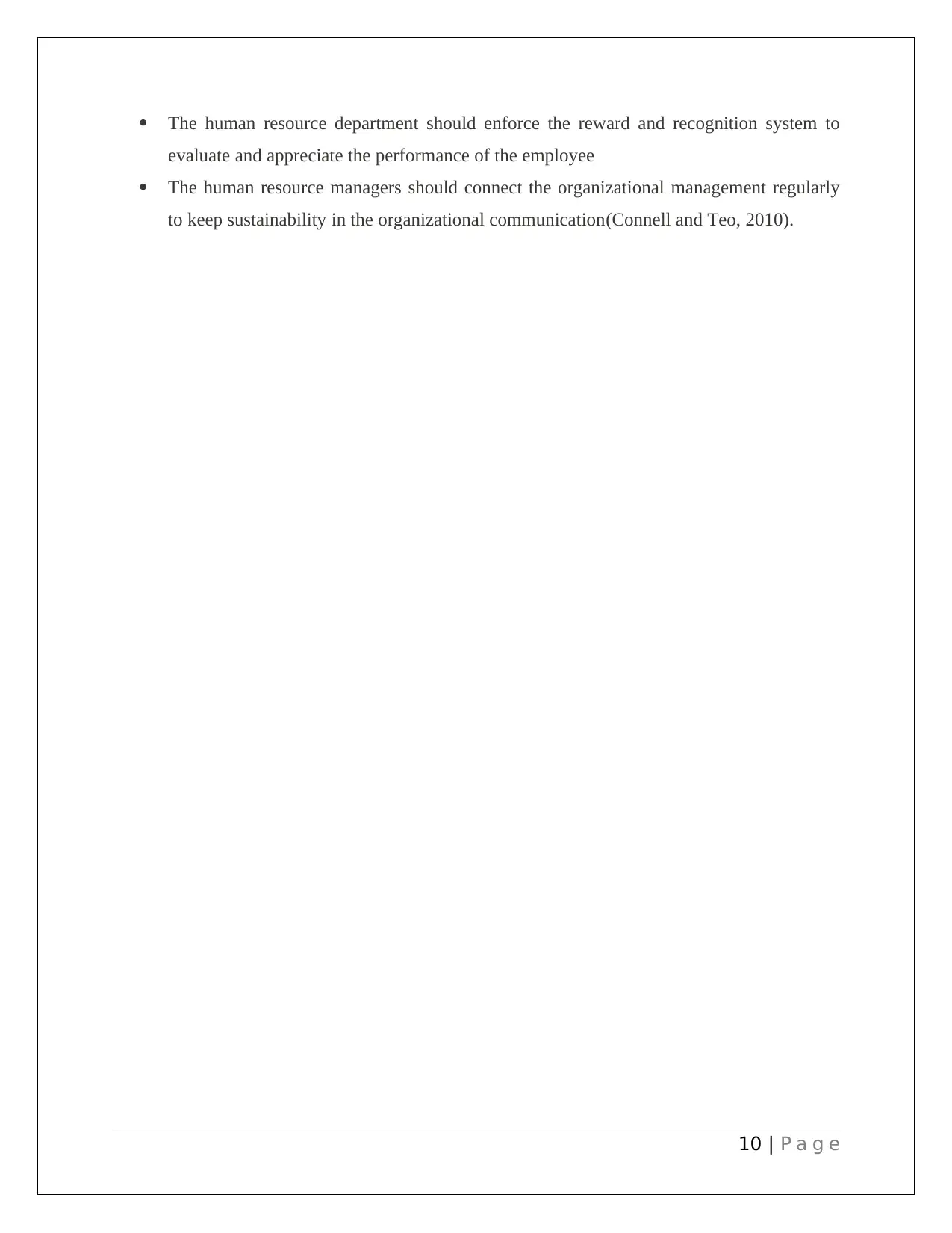
The human resource department should enforce the reward and recognition system to
evaluate and appreciate the performance of the employee
The human resource managers should connect the organizational management regularly
to keep sustainability in the organizational communication(Connell and Teo, 2010).
10 | P a g e
evaluate and appreciate the performance of the employee
The human resource managers should connect the organizational management regularly
to keep sustainability in the organizational communication(Connell and Teo, 2010).
10 | P a g e
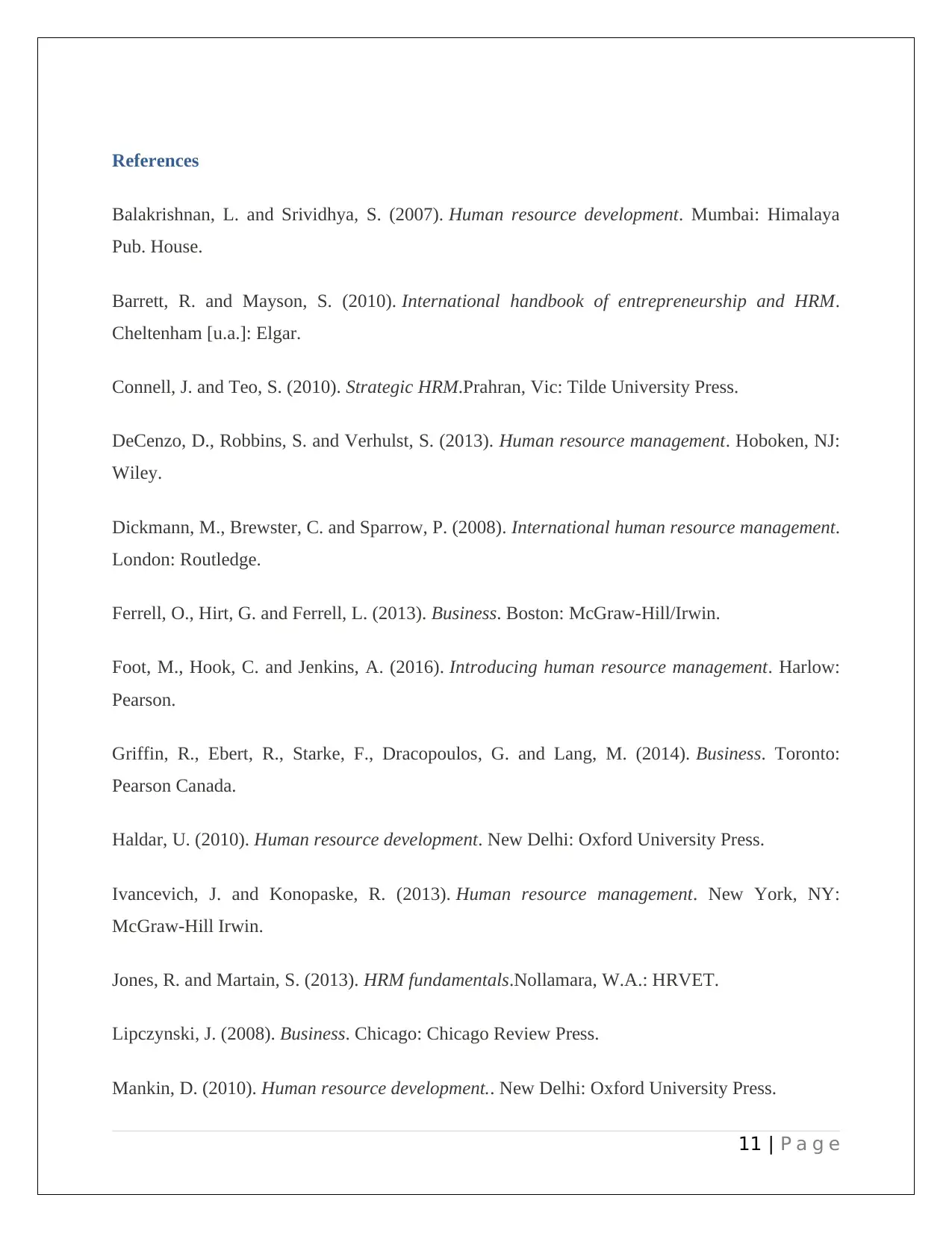
References
Balakrishnan, L. and Srividhya, S. (2007). Human resource development. Mumbai: Himalaya
Pub. House.
Barrett, R. and Mayson, S. (2010). International handbook of entrepreneurship and HRM.
Cheltenham [u.a.]: Elgar.
Connell, J. and Teo, S. (2010). Strategic HRM.Prahran, Vic: Tilde University Press.
DeCenzo, D., Robbins, S. and Verhulst, S. (2013). Human resource management. Hoboken, NJ:
Wiley.
Dickmann, M., Brewster, C. and Sparrow, P. (2008). International human resource management.
London: Routledge.
Ferrell, O., Hirt, G. and Ferrell, L. (2013). Business. Boston: McGraw-Hill/Irwin.
Foot, M., Hook, C. and Jenkins, A. (2016). Introducing human resource management. Harlow:
Pearson.
Griffin, R., Ebert, R., Starke, F., Dracopoulos, G. and Lang, M. (2014). Business. Toronto:
Pearson Canada.
Haldar, U. (2010). Human resource development. New Delhi: Oxford University Press.
Ivancevich, J. and Konopaske, R. (2013). Human resource management. New York, NY:
McGraw-Hill Irwin.
Jones, R. and Martain, S. (2013). HRM fundamentals.Nollamara, W.A.: HRVET.
Lipczynski, J. (2008). Business. Chicago: Chicago Review Press.
Mankin, D. (2010). Human resource development.. New Delhi: Oxford University Press.
11 | P a g e
Balakrishnan, L. and Srividhya, S. (2007). Human resource development. Mumbai: Himalaya
Pub. House.
Barrett, R. and Mayson, S. (2010). International handbook of entrepreneurship and HRM.
Cheltenham [u.a.]: Elgar.
Connell, J. and Teo, S. (2010). Strategic HRM.Prahran, Vic: Tilde University Press.
DeCenzo, D., Robbins, S. and Verhulst, S. (2013). Human resource management. Hoboken, NJ:
Wiley.
Dickmann, M., Brewster, C. and Sparrow, P. (2008). International human resource management.
London: Routledge.
Ferrell, O., Hirt, G. and Ferrell, L. (2013). Business. Boston: McGraw-Hill/Irwin.
Foot, M., Hook, C. and Jenkins, A. (2016). Introducing human resource management. Harlow:
Pearson.
Griffin, R., Ebert, R., Starke, F., Dracopoulos, G. and Lang, M. (2014). Business. Toronto:
Pearson Canada.
Haldar, U. (2010). Human resource development. New Delhi: Oxford University Press.
Ivancevich, J. and Konopaske, R. (2013). Human resource management. New York, NY:
McGraw-Hill Irwin.
Jones, R. and Martain, S. (2013). HRM fundamentals.Nollamara, W.A.: HRVET.
Lipczynski, J. (2008). Business. Chicago: Chicago Review Press.
Mankin, D. (2010). Human resource development.. New Delhi: Oxford University Press.
11 | P a g e
⊘ This is a preview!⊘
Do you want full access?
Subscribe today to unlock all pages.

Trusted by 1+ million students worldwide
1 out of 13
Related Documents
Your All-in-One AI-Powered Toolkit for Academic Success.
+13062052269
info@desklib.com
Available 24*7 on WhatsApp / Email
![[object Object]](/_next/static/media/star-bottom.7253800d.svg)
Unlock your academic potential
Copyright © 2020–2025 A2Z Services. All Rights Reserved. Developed and managed by ZUCOL.




